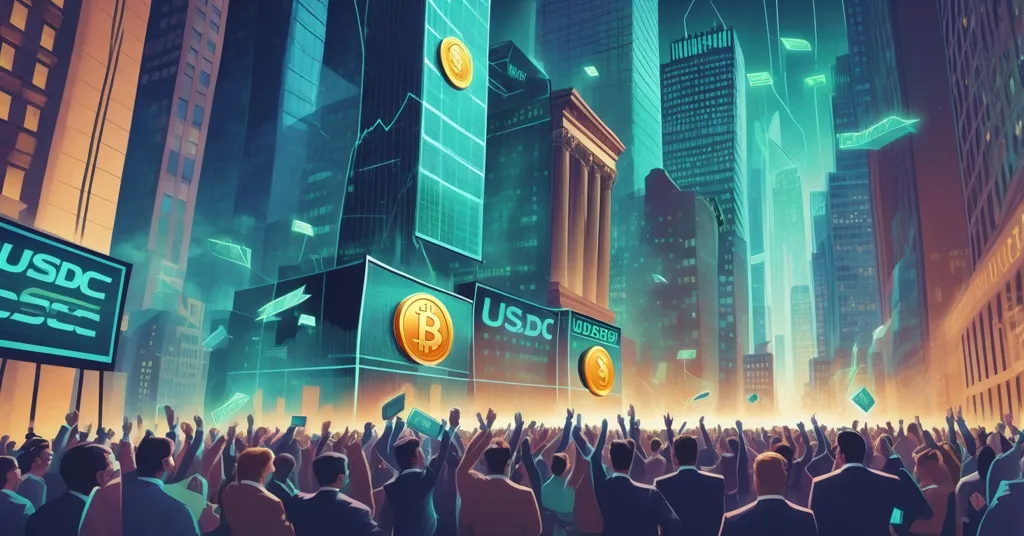Circle’s Stock Soars 174% on NYSE Debut: USDC Giant Shakes Up Wall Street

Circle’s Stock Blasts Off with 174% Surge on NYSE Debut: A Stablecoin Giant Goes Mainstream
Circle, the fintech heavyweight and issuer of the USDC stablecoin, has made a thunderous entrance onto the New York Stock Exchange under the ticker $CRCL, with its stock price rocketing 174% from an IPO of $31 to an opening of $69 per share. This explosive debut not only marks a historic triumph for Circle but signals a seismic shift in how blockchain and crypto infrastructure are perceived on Wall Street, potentially paving the way for more digital asset firms to follow in 2025.
- Unprecedented Rally: Shares surged 174% from $31 to $69, peaking at $84.92 before a trading halt due to extreme volatility.
- Valuation Powerhouse: With 34 million shares listed, Circle’s market value hit $6.8 billion, potentially reaching $8.1 billion fully diluted.
- USDC’s Muscle: Circle’s USDC stablecoin boasts a $61.5 billion market cap, doubling in supply over the past year and driving fintech adoption.
A Debut That Stopped Trading—Literally
The first day of trading for Circle was a rollercoaster that even the most hardened crypto traders would gawk at. Pre-market expectations had pegged the opening price between $48 and $50, but when the market opened, shares exploded to $69, a staggering 174% leap from the $31 IPO price. The frenzy didn’t stop there—prices peaked at $84.92 before a limit up circuit breaker, a mechanism that pauses trading when a stock rises too fast to curb runaway volatility, forced a temporary halt. Circle raised $1.05 billion by offering 34 million shares, securing an initial valuation of $6.8 billion. When you factor in options and other securities—a concept known as fully diluted valuation—that figure swells to $8.1 billion. For a company rooted in the often scoffed-at crypto space, this is a middle finger to the naysayers who’ve called blockchain a fleeting gimmick.
Jeremy Allaire, Circle’s Founder and CEO, didn’t hold back on the significance of the moment.
This moment is one of the most exciting moments of my life,
he declared, capturing over a decade of pushing crypto into the mainstream. Chief Strategy Officer Dante Disparte echoed the sentiment with a nod to their broader vision, stating,
At Circle, our mission to raise global economic prosperity through the frictionless exchange of value has never wavered, and today I am proud to share that Circle is now a public company.
Beyond the corporate polish, their words point to a bold ambition: creating a payment layer for the internet, fusing crypto’s raw innovation with the practicality of day-to-day transactions.
USDC: The Digital Dollar Powering Circle’s Rise
Circle’s meteoric debut isn’t just about stock prices—it’s deeply tied to the trust and utility of USDC, the second-largest stablecoin globally with a market cap of $61.5 billion. For those new to the game, a stablecoin is a cryptocurrency engineered to maintain a steady value, usually pegged to a fiat currency like the U.S. dollar. Picture it as digital cash: while Bitcoin or Ethereum can swing 10% in a day, USDC stays rock-steady at $1 per token by being backed with real-world assets like cash and short-term U.S. Treasuries. This makes it a lifeline for digital payments, trading in decentralized finance (DeFi) platforms, and even wild meme coin speculation on networks like Solana. If you’re curious to learn more about its background, check out the detailed history of USDC.
Since launching in 2018, USDC has powered over $25 trillion in transactions on blockchain networks, with its circulating supply doubling in just the past year. It’s embedded in the crypto ecosystem—think lending and borrowing on DeFi platforms like Aave, fueling meme token trading frenzies on Solana, or enabling payments via fintech giants like Stripe, which recently re-embraced USDC. Circle isn’t stopping at the dollar, either. Their Euro-backed stablecoin, EURC, is gaining traction in the Euro Area, a clear sign of their global ambitions. Think of a freelancer in Berlin getting paid instantly in EURC without bank delays—that’s the kind of frictionless future Circle is betting on.
So how does Circle cash in? They earn interest on the reserves backing USDC, a model that’s paid off handsomely with rising U.S. interest rates. Their first-quarter 2025 earnings showed a profit of $64.8 million on revenue of $578.6 million, numbers that likely had investors salivating during the IPO. From crypto OGs to traditional Wall Street funds, demand was reportedly off the charts, with many seeing USDC as a safer harbor than the speculative altcoin casino, as reflected in community discussions around the IPO hype.
Regulatory Chess: Compliance as a Competitive Edge
Circle isn’t just a crypto player—they’re playing 4D chess with regulators in a space often branded as the Wild West. Their 12-year obsession with compliance sets them apart, especially as they’ve aligned with heavy-hitting frameworks like the EU’s Markets in Crypto-Assets (MiCA) regulation. MiCA, for the uninitiated, is a set of rules aimed at governing digital assets across Europe, focusing on transparency, consumer protection, and market stability. Stateside, a more crypto-friendly vibe under recent U.S. political shifts, coupled with proposals like the GENIUS Act for stablecoin clarity, gave Circle the perfect window to go public. Their commitment to these standards is evident in their transparent reporting on USDC backing assets.
Compliance isn’t just a checkbox for them—it’s a weapon. Circle has frozen 292 wallet addresses at the behest of authorities to tackle fraud, and in a high-profile move, locked down $57 million in USDC tied to the LIBRA meme token crash to compensate victims. These actions scream accountability, a rare sight in crypto’s scam-ridden corners. But here’s the rub: as a Bitcoin maximalist at heart, I can’t ignore the centralization stench. Circle’s ability to freeze funds means they wield godlike control over “your” assets, a far cry from Bitcoin’s untouchable, peer-to-peer ethos. Yet, let’s not bullshit ourselves—when rug pulls and hacks bleed users dry weekly, these centralized guardrails might be the ugly compromise needed to drag normies into the fold. Circle’s balancing act between disruptive tech and regulatory handshakes is working, for now.
USDC vs. USDT: The Stablecoin Smackdown
Circle’s story isn’t complete without sizing up Tether’s USDT, the stablecoin kingpin with a $153.8 billion market cap. Both aim to be the digital dollar of the crypto realm, but their paths diverge sharply. USDT has been dogged by questions over its reserves—nobody’s fully convinced every token is backed 1:1, with transparency reports often raising eyebrows. Circle, on the other hand, plays the straight-A student, releasing regular audits showing USDC’s reserves are fully backed by cash and Treasuries. This has won them brownie points with institutions and regulated platforms—think Visa or Stripe picking a stablecoin partner; USDC often gets the nod. For a deeper dive, explore this comparison between USDC and USDT.
Still, USDT dominates raw volume, especially in markets like Asia where liquidity trumps trust. Circle’s carving a niche as the “reliable” stablecoin, but catching Tether’s crown means battling entrenched user bases and deep market penetration. This isn’t just corporate drama—it’s a fight over who shapes the backbone of digital money in a blockchain-driven future. Will trust win over ubiquity? Circle’s betting hard on the former.
Turning Down Billions: Circle’s Solo Gamble
Amid the IPO hype, unverified rumors swirl that Ripple, Inc. offered to buy Circle for anywhere between $5 billion and $20 billion. If true, rejecting such a payday to go public instead screams confidence—or audacity. Why settle for a buyout when you can storm Wall Street on your terms? This isn’t just a flex for Circle; it’s a potential catalyst for the industry, as explored in various online discussions about the rumored Ripple offer. As the first major crypto-related listing of 2025, their debut could inspire a wave of blockchain firms—custody providers, DeFi protocols, maybe even miners—to test the public market waters. Circle has kicked down a door that’s been barricaded for years, and every crypto startup with big dreams is taking notes.
The Dark Side of the Hype: Risks You Can’t Ignore
Before we pop the champagne, let’s splash some cold reality on this party. Circle’s first-day volatility, with trading halts triggered by insane price swings, is a neon sign that crypto-adjacent firms come with baggage. Regulatory uncertainty is a guillotine waiting to drop—today’s friendly policies could flip tomorrow with a single law. Look at China’s crypto bans or India’s tax nightmares; billions can evaporate overnight. Circle’s revenue also teeters on shaky ground: it’s tied to interest rates, which could fall, and USDC adoption, which isn’t a guaranteed hockey-stick graph. For insights into potential regulatory hurdles, see this discussion on stablecoin challenges.
Then there’s the eye-watering valuation—$6.8 billion, or $8.1 billion fully diluted. That’s a hell of a price for a sector as erratic as a Bitcoin bull run. Long-term profitability? Not etched in stone. Newbies and seasoned investors alike need to keep their wits sharp; this isn’t a sure bet. And as someone who worships at the altar of decentralization, I’ve got to ask: are stablecoins like USDC really pushing financial freedom, or just slapping a blockchain sticker on the same old fiat cage? Are we disrupting the system, or cozying up to it with extra steps?
A Litmus Test for Crypto’s Mainstream Dreams
Circle’s NYSE splash isn’t just their victory lap—it’s a gauge of how far blockchain can infiltrate traditional finance. Compare it to Coinbase’s 2021 IPO, which soared initially but cratered under regulatory heat and market slumps. Circle’s entering a more mature crypto landscape with clearer use cases for stablecoins, but they’re not bulletproof. A crypto winter or a policy fumble could tank their stock faster than a leveraged liquidation. Still, their debut hints at Wall Street warming up to blockchain infrastructure, potentially greenlighting other firms to chase public listings, as noted in reports on the broader impact of Circle’s listing.
I’m torn as a champion of decentralization and effective accelerationism. Circle’s vision of frictionless value exchange vibes with the fight for financial sovereignty, but their centralized controls and regulatory cuddling clash with Bitcoin’s middle-finger-to-the-system roots. That said, I can’t deny the practical niches stablecoins fill—fast, stable transactions are a gateway for the masses who’d never touch BTC’s volatility. Circle might not be pure P2P, but they’re a stepping stone to a world where money flows freer than ever. The real question is whether they’re crafting the future of finance or just polishing the old guard with crypto glitter. Time will tell if this hype holds—or if it’s another pump primed to dump. For a closer look at the IPO specifics, review the detailed coverage of Circle’s NYSE performance.
Key Questions and Takeaways on Circle’s Blockbuster NYSE Debut
- What sparked Circle’s 174% stock surge on debut?
Unrelenting investor excitement for blockchain and fintech, paired with a massively oversubscribed IPO, propelled the rally, though volatility forced a trading halt as prices spiked to $84.92. - Why is USDC the linchpin of Circle’s success?
Boasting a $61.5 billion market cap, USDC’s stability and integration into DeFi, Solana meme trading, and fintech apps like Stripe make Circle a titan in digital finance. - How does USDC stack up against Tether’s USDT?
USDC lags behind USDT’s $153.8 billion cap but shines with transparency via regular audits, earning trust from regulated platforms where Tether’s reserve opacity raises red flags. - Why does Circle lean so hard into regulatory compliance?
Aligning with frameworks like the EU’s MiCA builds mainstream credibility and adoption, though asset freezes fuel debates among decentralization diehards. - What risks could derail Circle’s post-IPO momentum?
Regulatory U-turns, dependence on interest rates, and market unpredictability pose threats, despite a dazzling $6.8 billion valuation and early success. - Could Circle’s IPO reshape crypto’s Wall Street presence?
As the first major crypto listing of 2025, it showcases growing acceptance of blockchain firms, possibly inspiring DeFi platforms and others to pursue public offerings. - Does Circle truly advance financial freedom?
Their goal of seamless transactions supports broader access, but centralized controls beg the question: are stablecoins revolutionary or just a rebranded traditional system?



